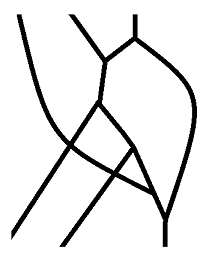Here is an attempt. Not a full answer, rather a suggestion of an approach.
Instead of triangles let us look at nodes with three strings coming out of them. So, for the triangle of type "A" let us write
and for the triangle of type "B" let us write
The bottom line is that the strings that go upwards from the node correspond to OUT-sides, and strings that go downwards from the node correspond to IN-sides. Let us regard these pictures as string diagrams http://ncatlab.org/nlab/show/string+diagram. Then we can compose them as we compose string diagrams. Some of the possible compositions are:
We allow strings to intersect each other (as is the case in the leftmost diagram). Such compositions should correspond to the "triangle compositions". So as the leftmost diagram above is "A1 + 0B", the second diagram is "A1 + 1B" and the third diagram is "B + A" as in OP. The
Triangle tilings which are obtained inductively by adjoining one tile by a single edge at a time are representable by string diagrams. On the other hand, a tiling can be constructed from a string diagram that has no cycles. These can be shown by induction on number of tiles/nodes. I believe that there is a one-to-one correspondence between tilings and string diagrams of these types.
For more complicated tilings things get more difficult. Anyway, the "cycle" in the OP would be
After this category theory and string diagrams tell us how to solve the problem of notation. We can imagine that we are inside a symmetric monoidal category where we have an object $X$ and two morphisms $f : X\otimes X \rightarrow X$ and $g : X \rightarrow X\otimes X$ corresponding to the triangles "A" and "B" respectively (more concretely say that we are in the symmetric monoidal category free on such a data). Then the notation comes from the string calculus for a symmetric monoidal category. Thus for example, "A1 + 0B" would be the composite
$$X\otimes X \xrightarrow{1_X\otimes g} X\otimes X\otimes X \xrightarrow{s\otimes 1_X} X\otimes X\otimes X \xrightarrow{1_X\otimes f} X\otimes X,$$
where $s$ stands for the symmetry of the monoidal category.




